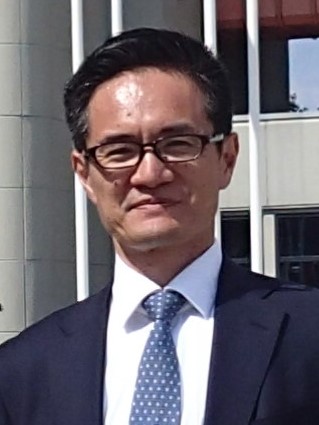Mitsuo YAMAMOTO, Professor
・Standing Faculty, International Program in Agricultural Development Studies (IPADS)
Laboratory of Agricultural Development Studies, Global Biological and Environmental Sciences
Department of Global Agricultural Sciences, Graduate School of Interdisciplinary Information Studies, the University of Tokyo

Phone: +81-3-5841-7575
>EMAIL (myamamoto[at]g.ecc.u-tokyo.ac.jp)
Professional Experience & Education
| 2023~Present | Professor, Graduate School of Agricultural and Life Sciences, The University of Tokyo |
|---|---|
| 2019~2023: | Associate Professor, Graduate School of Agricultural and Life Sciences, The University of Tokyo |
| 2014: | Project Associate Professor, Ocean Alliance, The University of Tokyo |
| 2012: | Project Associate Professor, Graduate School of Frontier Sciences, The University of Tokyo / Atmosphere and Ocean Research Institute, The University of Tokyo |
| 2010: | Project Associate Professor, College of Arts and Sciences, The University of Tokyo |
| 2007: | Project Lecturer, College of Arts and Sciences, The University of Tokyo |
| 2003: | Assistant Professor, Graduate School of Engineering, The University of Tokyo |
| 2002: | Postdoctoral Fellow, Graduate School of Engineering, The University of Tokyo |
| 2002: | Ph.D., Graduate School of Engineering, The University of Tokyo |
| 1997: | B.S., Faculty of Engineering, The University of Tokyo |
Discipline(s)
Environmental Science, Aquatic Environmental Chemistry, Environmental Chemical Engineering
Research interests
The major goal of my research is to contribute to the development of environmental technologies and ecosystem conservation through interdisciplinary and issue-oriented approaches. I have been conducting two studies mainly for developing marine environmental technologies and conserving coastal ecosystems focused on the linkage between forest, river and sea. At first, a seaweed bed restoration method using iron fertilizer has been developed. The lack of iron in coastal area was focused as a factor for depleting seaweed beds, so-called “barren ground.” The effectiveness of this method was confirmed as results of fundamental studies and a field test in Hokkaido. Meanwhile, I have evaluated material dynamics, such as iron, nitrogen and phosphorus, in the coastal areas and river basins for understanding the forest-river-sea linkage. I have focused on the influence of land use on estuarine environments in recent years.
In addition, I have engaged in interdisciplinary education in environmental and ocean related fields for developing human resources. I have been in charge of domestic and overseas internship programs in recent years. Graduate students have been sent to the international organizations in the overseas internship program. I evaluated educational effects of domestic and overseas internships on establishment of students’ career paths.
Study example for understanding the forest-river-sea linkage
- Influence of rice paddy fields on iron dynamics in rivers and the structural features of humic acids in their sediments of the northwest of Hokkaido, Japan
- Potential influence of oceanic environmental change on seaweed bed distribution in Tsushima Islands
- Influence of freshwater from terrestrial sources on iron concentrations in Kesennuma Bay, Japan
- Dynamics of iron in the Chikugo River Basin
- Changes in the coastal environment in Kamaishi Bay after the Great East Japan Earthquake
- Educational effect of internship for human resource development
<Primary papers>
- H. Iwai and M. Yamamoto, “Influence of land use on the structural feature of sedimentary humic acids in rivers in northwest Hokkaido, Japan,” Anal. Sci., 35(6) (2019) (in press).
- A. Aneksampant, A. Tanaka, X. Tu, H. Iwai, M., K. Nakashima and M. Fukushima, “Roles of microbial activity and anthraquinone-2,7-disulfonate as a model of humic substances in leaching of iron from hematite into seawater,” Analytical Sciences, 34(11) (2018) 1303-1308.
- M. Yamamoto, H. Nomura and S. Kimura, “Effectiveness of Overseas Internship for Developing International Marine Human Resources,” Journal of Japan Society of Ocean Policy, 7 (2017) 145-157 (peer-reviewed report, in Japanese).
- M. Yamamoto, T. Kato, S. Kanayama, K. Nakase and N. Tsutsumi, “Effectiveness of Iron Fertilization for Seaweed Bed Restoration in Coastal Area,” Journal of Water & Environment Technology, 15(5) (2017) 186-197.
- M. Yamamoto, D. Liu, A. Kasai, K. Okubo and M. Tanaka, “Dynamics of iron in the Chikugo River Basin: Comparison of iron with nitrogen and phosphate input to the estuary,” Regional Studies in Marine Science, 8 (2016) 89-98.
- M. Yamamoto and S. Kimura, “The educational effect of an internship program established for new ocean-related career paths,” Journal of Japan Society of Ocean Policy, 6 (2016) 117-129 (in Japanese).
- M. Yamamoto, T. Kato, S. Tabeta, D. Kitazawa, M. Fujino, K. Shozugawa, M. Matsuo, K. Tanaka and Y. Michda, “Changes in the coastal environment in Kamaishi Bay after the Great East Japan Earthquake,” Nippon Suisan Gakkaishi, 81(2) (2015) 243-255 (in Japanese).
- M. Yamamoto and M. Fukushima, “Humification index of composts originating from three types of woody biomass,” J. Mater. Cycles Waste Manage, 16(4) (2014) 731-738.
- M. Yamamoto, M. Fukushima, E. Kiso, T. Kato, M. Shibuya, S. Horiya, A. Nishida, K. Otsuka and T. Komai, “Application of Iron Humates to Barren Ground in a Coastal Area for Restoring Seaweed Beds,” J. Chem. Eng. Jpn, 43(7) (2010) 627-634.
- M. Yamamoto, A. Nishida, K. Otsuka, T. Komai and M. Fukushima, “Evaluation of the binding of iron(II) to humic substances derived from a compost sample by a colorimetric method using ferrozine,” Bioresour Technol, 101(12) (2010) 4456-4460.